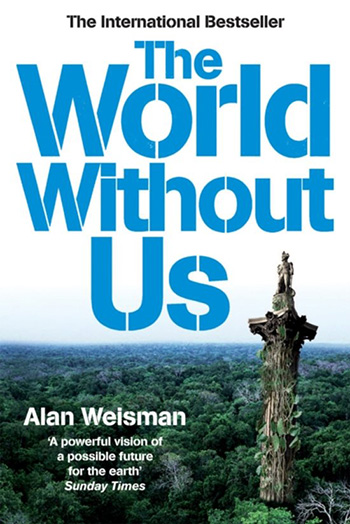‘The World Without Us’

The World Without Us
by Alan Weisman
Virgin Books Ltd, Random House,
London 2007
287 pages
Hardback, Paperback and Kindle: amazon.com
It was a strange interlude, when I lived in Missouri between 2005-2012. I was in a warm, loving, somehow silent relationship, and we lived in a huge house I had been able to decorate as I pleased – eco-friendly bamboo flooring, clay wall-paint, and the like. After a long drifting time, my yearning to be the chatelaine of a big clean house had come true – 5 bedrooms, 2 sitting rooms, huge open kitchen. I’d planted 23 trees.
But the surrounding territory was a spiritual and cultural desert. Huge people, as if swollen up to try to fit into the vastness of the prairies; buttoned-up dwellings, Christian churches and enormous box stores both acting as temples to worship in. I’d done my best to make friends, but it had barely worked. I had the lonesome heebie-jeebies, bad.
I used to spend hours each evening cooking an elaborate, picturesque supper and then cleaning up after the meal. This was made pleasant by listening to audio books, which I got from the local library. And so it was that into that air of determined security there came the voice of a curiously graceful apocalypse: The World Without Us, which looks at what would happen to both the natural world and the man-made one – if we, all of us, were suddenly no longer here. (The author gives the chilling proposal that we’ve all died of a super-virus, either natural or engineered. Though he later says this is not a very likely reason for absolutely all of us being gone.)
Early in the book we hear a farmer say, “If you want to destroy a barn, cut an 18-inch square hole in the roof. Then stand back.” We hear how long each component of a house, a factory, a nuclear installation, a dam, takes to break down and transform itself into something else.
I don’t in the least want us all to disappear overnight (well, with maybe a few exceptions) though I do have a great respect for how all kinds of fuck-ups are needed for the greater scheme of things (including, I hope, yrs truly), but oh it was restful to hear about all our works coming undone, rusting, breaking, rotting, toppling, vanishing under trees.
It was particularly restful in that place – where I felt trapped by the success and the sameness. Where the only drama was provided by the grouchy cat’s antics and the occasional threat of tornadoes. (The house-cat, by the way, is an eco-disaster when it is outdoors hunting. And it looks to outlive us and flourish.)
Without us, the trees we now don’t have enough of would come back fast – though we’d not be here to rest under them. Animals, birds, would keep pace and after a hundred or so years, most domesticated creatures would die out. Even radiation-contaminated places could soon be climbing with rodents quick-evolved to handle the radiation, though many animals would never adjust. The 30,000 warheads we’d leave behind would take 250,000 years to degrade. 441 nuclear plants would still be giving off poison.
Mosquitoes would thrive – they don’t need our paltry blood-volume; at the time this book was written, it had been posited that the total bio-mass of humans on Earth would not even fill up the Grand Canyon. Mozzies have so many other supplies; and male mosquitoes’ principal food is flower-nectar! They actually are pollinators, so their presence would help the Earth flower (again without our being able to appreciate it). Mozzie habitat will expand as wetlands return and the many billions of rubber tires we leave behind will float inexorably upwards in landfills and become helpful rainwater-traps. Freshwater fish that eat mosquito larvae will also benefit.
Before we were here, there were ground-sloths in Florida weighing 1,000 pounds; in Argentina weighing 13,000 pounds; in the Grand Canyon, 500 pounds. There were many other mega-fauna – but when humans came to the New World, within a thousand years all the huge beasts were gone. Without us, huge slow creatures could evolve again, feeding on the wild masses of vegetation there would be nobody to spray, chop, mow, or strim away.
All the construction components I’d just been getting familiar with as I’d overseen the renovation of our house – floor tiles, particle board, windows, beams, roof tiles – I could see fading, kneeling, cracking, keeling over. This brought it home – a house is not a permanent safety. It is the result of ceaseless labour that we don’t have tree-roots poking through our floors, branches stoving our roofs in.
I find it wonderful that this Earth will, of course, go on – changing always, free to grow stupendously tall trees again, time vanishing into cycles. This beautiful Earth, thriving without us – though for ages to come having to somehow cope with plastics, chemicals, etc.
The writing is clear, calm, and elegant, and you can feel the peace in it all – the cessation of noise. It is a bit like meditation – what is there when there is no mind. The thesis is sad, but somehow poetic. And somehow bracing – for sanity perhaps we need to be able to see outside ourselves – and this book gives us a solid glimpse.
There are photos taken by the author, who travelled to the places he wrote about.
- Log in to post comments
- 9 views
